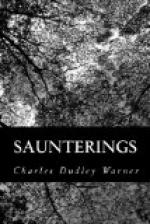In front of the cathedral is the well, and the fine canopy of iron-work, by Quentin Matsys, the blacksmith of Antwerp, some of whose pictures we saw in the Museum, where one sees, also some of the finest pictures of the Dutch school,—the “Crucifixion” of Rubens, the “Christ on the Cross” of Vandyke; paintings also by Teniers, Otto Vennius, Albert Cuyp, and others, and Rembrandt’s portrait of his wife,—a picture whose sweet strength and wealth of color draws one to it with almost a passion of admiration. We had already seen “The Descent from the Cross” and “The Raising of the Cross” by Rubens, in the cathedral. With all his power and rioting luxuriance of color, I cannot come to love him as I do Rembrandt. Doubtless he painted what he saw; and we still find the types of his female figures in the broad-hipped, ruddy-colored women of Antwerp. We walked down to his house, which remains much as it was two hundred and twenty-five years ago. From the interior court, an entrance in the Italian style leads into a pleasant little garden full of old trees and flowers, with a summer-house embellished with plaster casts, and having the very stone table upon which Rubens painted. It is a quiet place, and fit for an artist; but Rubens had other houses in the city, and lived the life of a man who took a strong hold of the world.
AMSTERDAM
The rail from Antwerp north was through a land flat and sterile. After a little, it becomes a little richer; but a forlorner land to live in I never saw. One wonders at the perseverance of the Flemings and Dutchmen to keep all this vast tract above water when there is so much good solid earth elsewhere unoccupied. At Moerdjik we changed from the cars to a little steamer on the Maas, which flows between high banks. The water is higher than the adjoining land, and from the deck we look down upon houses and farms. At Dort, the Rhine comes in with little promise of the noble stream it is in the highlands. Everywhere canals and ditches dividing the small fields instead of fences; trees planted in straight lines, and occasionally trained on a trellis in front of the houses, with the trunk painted white or green; so that every likeness of nature shall be taken away. From Rotterdam, by cars, it is still the same. The Dutchman spends half his life, apparently, in fighting the water. He has to watch the huge dikes which keep the ocean from overwhelming him, and the river-banks, which may break, and let the floods of the Rhine swallow him up. The danger from within is not less than from without. Yet so fond is he of his one enemy, that, when he can afford it, he builds him a fantastic summer-house over a stagnant pool or a slimy canal, in one corner of his garden, and there sits to enjoy the aquatic beauties of nature; that is, nature as he has made it. The river-banks are woven with osiers to keep them from washing; and at intervals on the banks are piles of the long withes to be used in emergencies when the swollen streams threaten to break through.




